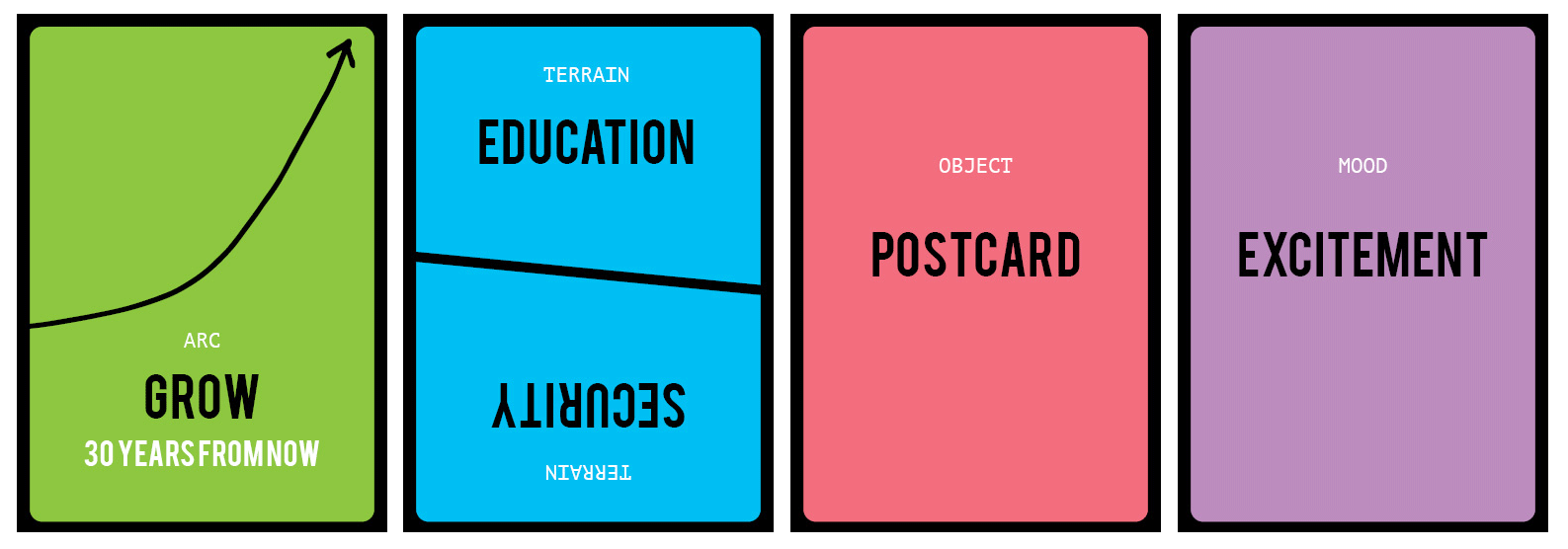Foresight Tools

All plans and, therefore, all strategy is about the future. Reports are about the past but what organizations should do in the future is all about planning. And, the context for how those plans are developed, along with their assumptions, changes everything about their accuracy and/or usefulness. In order to make appropriate plans, we need a clear understanding of the present, and its context, and a vision for the possible futures that might occur—as well as tools to understand, build, and communicate those futures. This is what Foresight tools are all about.
Start with the Present, move to the Future.
Now, not all foresight tools start with the present, but the very few that don’t are tricky to use, require expertise, and eventually require an understanding of the present in order to develop meaningful strategy. Most, however, require some kind of depiction of the world that currently exists as a foundation for jumping-off into other possibilities.
Many businesspeople discount foresight as being too impractical or theoretical. In doing so, they expose ignorance of their own activities and responsibilities. They’re already involved in foresight. The only difference is the timeframe they think relevant and the comfort they have in doing so. When they develop a “vision statement” as part of a strategic plan, this is foresight: a vision for the future. In fact, no one should be developing a vision statement without employing foresight tools (which is why most vision statements are worthless restatements of mission statements).
This is why foresight is so important and, thankfully, there are many kinds of foresight tools. They use different techniques, perspectives, and processes. Some look very far out and others just a few years. Some concentrate only on technological advances (which are a mistake), while others blend issues and impacts that span markets, competitors, people, technology, and the planet, itself (like any proper strategy).
In building a foundation for foresight, most organizations are at a disadvantage because their understandings of their current situations are impoverished by the strategy marketing tools they use and what data they put into them. Most corporate leaders eschew data that isn’t quantitative, missing the most valuable data that leads to market and customer insight. This is because more market research techniques favor the quantitative as being easier, cheaper, and more reliable. Like economists, they jettison the most complex data—which they don’t understand—and dumb down their models until they’re reassuringly easy but catastrophically misleading. Qualitative data is a necessary component to understanding current market, industry, and customer context.
The next insight that foresight tools bring to strategy is that no strategic process should focus only on an organization, solely, or that of its industry or sector. Just like integrated market strategy needs to consider customer decision-drivers from a range of lens (social, political, legal, economic, functional, industry-specific, etc.), do, too, do foresight tools need to look out into the future through these lens.
In foresight workshops I’ve both attended and lead, scientists from a range of disciplines, philosophers, professionals from a range of industries and disciplines, educators, government officials, designers, engineers, etc. all bring important perspectives that help identify opportunities that can apply to any organization’s affairs.
There are a range of foresight tools available and experts who can apply them to most any situation:
- Scenario Planning
- Backcasting
- Forecasting
- Threat Analysis
- …and several more.
Each has its eccentricities, its strengths and weaknesses. Expert practitioners can employ one or more for specific needs.
As “flaky” as foresight tools are sometimes seem by “rational” people, most of these tools have actually come out of serious government agencies (like the US Department of Defense) and corporations. Scenario planning, for example, was developed for the US Army by think tanks like SRI and Rand, then evolved and refined in the strategic planning offices at corporations like Royal Dutch Shell, and then deployed and innovated further by consultancies like Global Business Network and the Institute for the Future. None of these are frivolous organizations. To be sure, foresight work can be a ‘fun” diversion from the day-to-day slog of corporate planning. But, it is still serious work that leads to valuable, unique insights as well as better plans, overall. Every organization should take time to engage foresight tools, at least annually for at least a couple days, in order to ground their assumptions about the world around them as well as the plans they make for their future. Luckily, more and more professionals and ever-better tools are available to do just this.
Tools:
Thing From TheFuture
Arup’s Drivers of Change
2020 Media Futures toolkit
Future-fit Business Benchmark
More tools (article)…
Books:
The Art of the Long View, by Peter Schwartz
What the Foresight, by Alida Draudt and Julia Rose West
Programs:
Center for the Study of Futures, ASU
Hawaii Research Center for Futures Studies
MDes in Strategic Foresight & Innovation, OCAD
Organizations:
Institute for the Future
Global Business Network